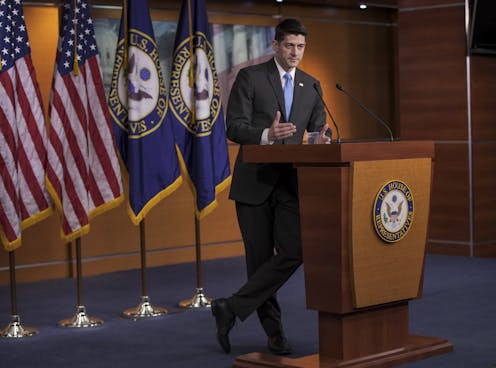What does the Speaker of the House do?
Paul Ryan, the Republican speaker of the House, just announced his retirement, and the race to replace him started before his announcement. What is the speaker's role? How has it changed over history?

Rep. Paul Ryan, Republican speaker of the House, announced this week he will retire from Congress.
What does the speaker do?
Second in the line of presidential succession after the vice president, the speaker occupies a central role in our national government.
Most people think the speakership is a party office. It’s not. The speaker is selected by the full House membership, though the majority party’s voting power ensures that the role is occupied by one of their own.
From legislation to accounting
The speaker fills three primary roles.
First, they are the most visible and authoritative spokesperson for the majority party in the House. Speakers articulate an agenda and explain legislative action to other Washington officials as well as the public. They oversee House committee assignments and collaborate with the powerful House Rules Committee to structure floor debate.
Second, the speaker manages business on the floor and navigates legislative rules, structuring House debate in a way that will advantage their legislative priorities. Adherence to strict rules and procedures is necessary to overcome the difficulty of managing a large legislative body like the House of Representatives.
Third, the speaker oversees everything from accounting to procurement for the House.

Power ebbed and flowed
During the republic’s early years, the speakership gradually gained power. By 1910, Speaker Joe Cannon had centralized power to such an extent that many of his own party members rebelled. Power was redistributed to committees and lower-level party leaders.
By the 1970s, committees had gained such control over legislative outcomes that widespread reforms were adopted, which shifted power back to the speaker.
From 1977 to 1995, three successive Democratic speakers – Thomas “Tip” O’Neill, Jim Wright and Tom Foley – reinvigorated the speakership. They enlarged the party leadership structure, creating wider networks of loyalty among members of the majority party while strengthening support for their priorities.
Today, the role of the speaker is influenced especially by changes instituted by Speaker Newt Gingrich, who took the gavel after the 1994 elections.
Gingrich, a Republican, was overtly partisan in the role. He announced that, compared to past speakers, he “was essentially a political leader of a grassroots movement seeking to do nothing less than reshape the federal government along with the political culture of the nation.”
Since Gingrich’s tenure, speakers are often criticized as too partisan and too powerful, trampling minority party interests. But this is the nature of the job in today’s Washington. Ryan united a fractured Republican conference to pass tax reform and other GOP policy goals, continuing the trend of strong majority party control.
Rachel Caufield does not work for, consult, own shares in or receive funding from any company or organisation that would benefit from this article, and has disclosed no relevant affiliations beyond their academic appointment.
Read These Next
Can the US ‘run’ Venezuela? Military force can topple a dictator, but it cannot create political aut
If Washington governs by force in Venezuela, it will repeat the failures of Afghanistan, Iraq and Libya:…
How Maduro’s capture went down – a military strategist explains what goes into a successful special
Months of preparation and intelligence gathering went into the mission to seize Venezuela’s president…
A predawn op in Latin America? The US has been here before, but the seizure of Venezuela’s Maduro is
The operation in Venezuela has echoes of Panama in 1989. But in ordering President Maduro’s capture,…






